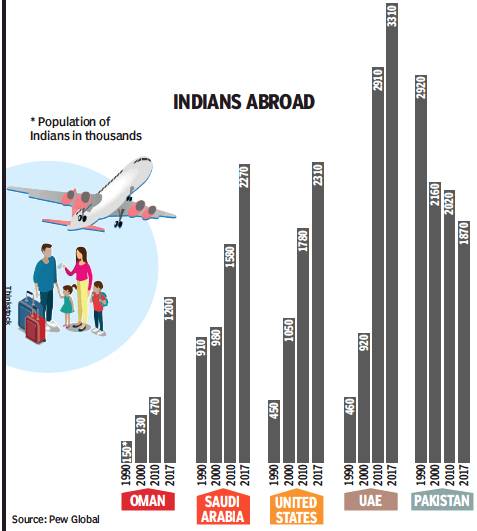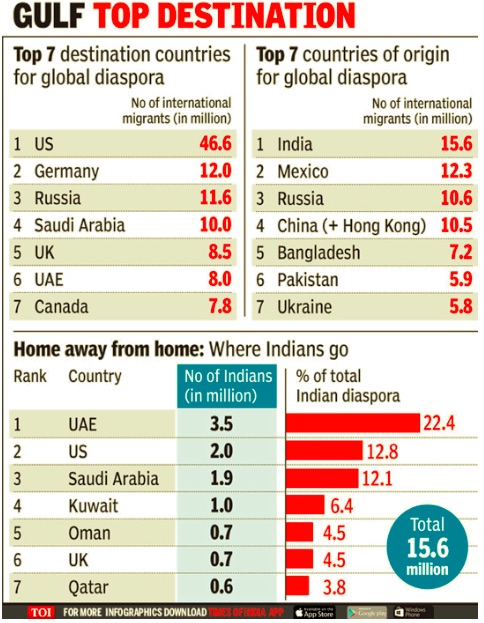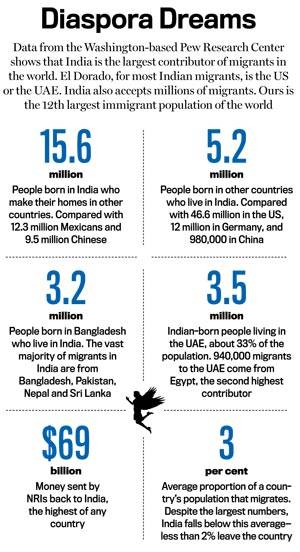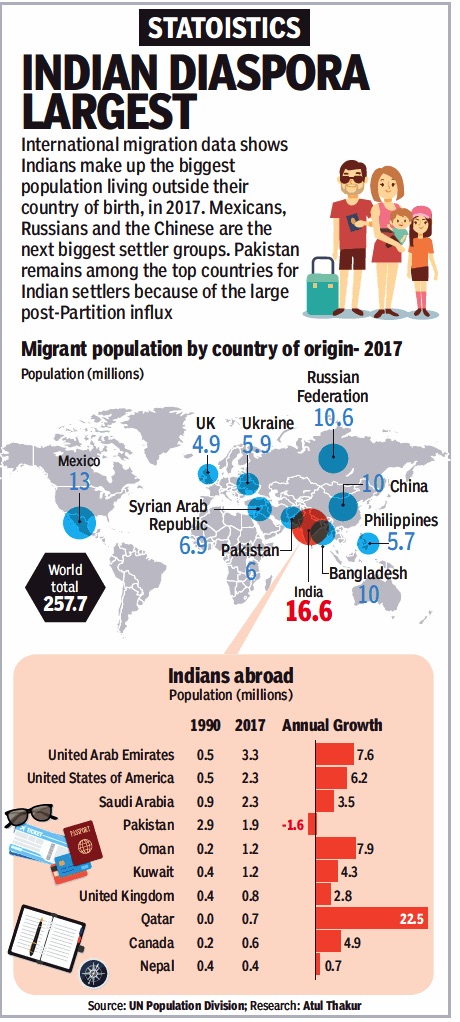Diaspora: India
(→Countries preferred most by Indian settlers) |
(→2016: India, Pakistan, Bangladesh and the world (in 2016?)) |
||
| Line 124: | Line 124: | ||
The number of migrants to the Gulf has dipped drastically in recent years, owing to economic conditions and the protectionist measures adopted by these countries. As reported earlier by TOI, pan-India emigration clearance for the Gulf in 2016, 5.07 lakh, showed a decline of 33% as compared to the previous calendar year. The decline trend has continued in 2017. | The number of migrants to the Gulf has dipped drastically in recent years, owing to economic conditions and the protectionist measures adopted by these countries. As reported earlier by TOI, pan-India emigration clearance for the Gulf in 2016, 5.07 lakh, showed a decline of 33% as compared to the previous calendar year. The decline trend has continued in 2017. | ||
| + | |||
| + | == 2017: Indian migrants abroad, Foreign born immigrants in India == | ||
| + | [https://www.indiatoday.in/magazine/up-front/story/20170320-narendra-modi-index-exposure-pullquote-maneka-gandhi-985960-2017-03-10 India Today Web Desk , Diaspora dreams “India Today” 20/3/2017] | ||
| + | |||
| + | ''' See graphic ''' | ||
| + | |||
| + | [[File:Diaspora dreams .jpg| Diaspora dreams [https://www.indiatoday.in/magazine/up-front/story/20170320-narendra-modi-index-exposure-pullquote-maneka-gandhi-985960-2017-03-10 .<br/>“India Today”]|frame|500px]] | ||
==2018: India, Pakistan, Bangladesh and the world == | ==2018: India, Pakistan, Bangladesh and the world == | ||
Revision as of 13:41, 21 February 2019
This is a collection of articles archived for the excellence of their content. |
Contents |
Countries preferred most by Indian settlers
2018: UAE, USA, Saudi Arabia, Pakistan, Oman
March 25, 2018: The Times of India

From: March 25, 2018: The Times of India
UAE, Saudi Arabia, Oman: Gulf countries remain top draw for Indian settlers
More Indians have settled abroad than any other people in the world. The UN says one out of every 20 emigrants today is Indian. That means about 1.7 crore of us, or roughly the population of Mumbai in 2010. For the UN, anyone who has lived in the same foreign country for more than a year is an emigrant. In which countries are India-born people most heavily concentrated? The UAE, USA, Saudi Arabia, Pakistan and Oman are the top five places now, but Pakistan was number 1 three decades ago. Oman has been the top destination since 2010.
Countries that prefer Indians
2015,’16: OECD countries
The total inflow of new immigrants to OECD countries was 70.6 lakh during 2016, a minuscule rise of less than 1% over the previous year’s figure of 70.4 lakh.
China retained its leadership position, accounting for 7.6% of the inflow. With 2.71 lakh new immigrants, India occupied fourth place and accounted for 3.8% of the total inflow. Over the past two years, migration from India has remained stagnant at 3.8%. However, in terms of standalone numbers, there was a small increase from 2.68 lakh in 2015 ,reports the International Migration Outlook (2018) released by OECD in Paris on June 20.
The Organisation for Economic Cooperation and Development (OECD) comprises of 35 member countries, including European countries, the United States of America, Canada, Australia, New Zealand and Japan.
For the first time, the International Migration Outlook, an annual publication, presented consolidated data on all categories of temporary labour migration. OECD countries were home to over 42 lakh temporary foreign workers during 2016. The main receiving countries for temporary foreign workers were Poland (which had 6.72 lakh workers) and the US (with 6.6 lakh workers).
In 2016, almost 21 lakh people acquired the nationality of an OECD country, up 3% from 2015, even as it remains within the OECD average of the last 10 years. India leads the pack, being the top origin country for naturalised foreigners (1.3 lakh).
Size of Diaspora
See graphic:
The estimated strength of the Indian Diaspora across the world, as in 2017

2015
2015: 1.30 lakh PIOs acquired OECD citizenship
1.3L in '15: India tops list of foreign citizenship, June 30, 2017: The Times of India

India tops the list of origin countries of naturalised citizens across the world, indicating that the diaspora is not apprehensive of acquiring foreign citizenship. In 2015, 1.30 lakh people of Indian origin, comprising largely of expatriates on work visas, acquired citizenship of OECD member countries.This was followed by Mexico (1.12 lakh) and the Philippines (94,000). China came fifth with 78,000 opting to relinquish their citizenship. These were the findings of the report International Migration Outlook (2017) released by Organisation of Economic Co-operation and Development (Oecd) in Paris on Thursday.
The report mentioned that in 2015, just over 20 lakh people acquired the nationality of an OECD country.This was slightly above (3%) the 2014 figure, even as it remains within the Oecd average of the past 10 years.
OECD is a global thinktank of 35 member countries, which include European countries, USA, Canada, Australia, New Zealand and Japan. An earlier Oecd report had pointed out that India had the world's largest diaspora with 156 lakh migrants.
“Improving the integration of immigrants and their children, including refugees, is vital to delivering a more prosperous, inclusive future for all,“ said OECD Secretary-General Angel Gurría in the report.
China retained its top position when it came to new immigrants to OECD countries.However, on this front, the refugee crisis led to a large influx of immigrants from Syria, pushing India down one spot to the fifth position. Humani tarian migration, rather than migration for better jobs or lifestyle, dominated the scene during 2015 and would continue to do so in the immediate future, the report stated. The total inflow of new immigrants to OECD countries in 2015 was 70.39 lakh and new immigrants from China accounted for nearly 7.8% of the inflow. In 2013, nearly one in ten immigrants were from China.
Migration flows from India to OECD also dipped slightly , from 4.4% of the total inflows countries in 2013 to just 3.9% in 2015. However, in terms of standalone numbers, there was an inflow of 2.68 lakh immigrations from India during 2015 to OECD countries, as opposed to just 2.40 lakh in 2013. (see table). Data showed that USA, Canada, UK, Australia and Germany continue to be the favoured destinations of Indian migrants.
Both China and India continued to be the major source countries for international students. Over half of the international students in the OECD countries originate from Asia. Chinese students, despite a 7% drop in their numbers between 2013 and 2014, were the most dominant with six lakh enrolments during 2014. They were followed by Indian students whose number at 1.86 lakh during 2014 was up by 13% compared with the previous year. USA received more than 40% international student enrolments.
2015/ Indian diaspora is world's largest at 16m: UN
The Times of India, Jan 14 2016
Somini Sengupta
UN: Indian diaspora is world's largest at 16m
According to the United Nations estimates, 244 million people, or 3.3% of the world's population, live in a country other than the one where they were born.Their ranks are growing at a faster pace than the world population as a whole, with enormous economic, social and demographic repercussions for their native and adopted countries.
However, they are concentrated in just 20 countries. By far, the most popular destination in 2015 was the United States, followed by Germany , Russia and Saudi Arabia. Indians make up the largest diaspora: 16 million Indians are scattered across the world, which partly reflects the country's demographic size (1.2 billion) and youth (median age is around 26).
After India, Mexico has the second largest diaspora, with 12 million living abroad, the majority of them in the US.
2015, Indians world's largest diaspora
Indians World's Largest Diaspora
The migration of Indians from the country to the United Arab Emirates (UAE) formed the second largest corridor in terms of number of migrants in 2015, according to a report released by the Organisation for Economic Cooperation and Development (OECD).
The flow of migrants from India to the UAE between 1995 and 2015 stood at 28 lakh, making UAE the top destination country for Indian migrants (It ranked fourth place in 1995).
The corridor between Mexico and the United States remains the largest in terms of the volume of migrants. In 2015, the flow from Mexico to US stood at nearly 55 lakh. Migration flow between 1995 and 2015 has been computed by OECD by taking the difference between the number of migrants in each of these two years.
In 2015, Indians accounted for the largest diaspora in the world with 156 lakh migrants, according to OECD's report -`Perspectives on global development, 2017: International migration in a shifting world.' The report points out that 24.3 crore people were living outside their country of birth in 2015, accounting for 3.3% of the world's population. This was a significant increase over the past twenty years -in 1995 only 2.7% of the world's pop ulation comprised of diaspo ra. The move of migrants has increasingly been towards high income countries.
The number of migrants from India living in the UAE grew by 126% between 2005 and 2010, accounting for nearly 20% of the global Indian mi grant stock in 2015 (In 1995, this constituted just 9% of India's diaspora). Immigrants now account for almost 70% of the total population in Kuwait and more than 80% in Qatar and the UAE. Indians are the sec ond largest immigrant group in the US, after Mexicans ac counting for 4.7% of the 413 lakh foreign born population.
A significant portion of Indi an immigrants in the US AS are recent arrivals: 51% of the total Indian born population arrived during or after 2000, compared to 36% of the foreign born population as a whole.
As regards the future, OECD's report said increasing protectionist measures were being adopted by high income countries, which should see a shift in the migration trends.
2016: India, Pakistan, Bangladesh and the world (in 2016?)
Lubna Kably, December 15, 2017: The Times of India
See graphic:
i) The countries to which Indians go;
ii) Top 7countries of origin for global diaspora;
iii) Number-Percentage of Indian diaspora, country-wise

ii) Top 7countries of origin for global diaspora;
iii) Number-Percentage of Indian diaspora, country-wise.
All figures presumably for 2016.
From: Lubna Kably, December 15, 2017: The Times of India
HIGHLIGHTS
Out of a global population of 7.3 billion, one of every 30 people was a migrant in 2015.
The Indian diaspora constitutes 6% of the total number of international migrants.
The Indian diaspora is the world's largest, with slightly more than 15.6 million people from India living overseas. The Indian diaspora constitutes 6% of the total number of international migrants (people living outside the country of their birth), which was estimated at 243 million in 2015. The global figure has risen by 10% over that recorded in 2010, a recently released United Nations report said.
In other words, out of a global population of 7.3 billion, one of every 30 people was a migrant in 2015. However, if computed as a percentage of the world's population, the growth of thediaspora has been largely static, from 3.2% in 2010 to 3.3% in 2015, according to the 'World Migration Report (2018)', published by the International Organisation for Migration, a UN agency.
According to the report, nearly half of all the international migrants worldwide in 2015 were born in Asia, primarily originating from India, China and other South Asian countries. After India, Mexico has the second largest diaspora. Russia, China, Bangladesh and Pakistan follow (see graphic). Notably, people in the working age group, between 20 to 64 years, account for a significant chunk of the international migrant population, nearly 72%. Since 1970, the US has been the main destination for international migrants.
The number of foreign-born people residing in the US has almost quadrupled from fewer than 12 million in 1970 to 46.6 million in 2015 (of whichnearly two million were of Indian origin). The Gulf nations house the biggest share of the Indian diaspora — nearly 3.5 million or 22% of the total Indian diaspora were in the UAE, and 1.9 million (or 12%) in Saudi Arabia.
According to immigration experts, protectionist measures adopted in these and other countries will eventually transform the diaspora landscape. We are witnessing intense vetting of applications for H-1B, the most popular work visa for Indians headed to the US, and entry into the US is likely to involve stricter rules.
The number of migrants to the Gulf has dipped drastically in recent years, owing to economic conditions and the protectionist measures adopted by these countries. As reported earlier by TOI, pan-India emigration clearance for the Gulf in 2016, 5.07 lakh, showed a decline of 33% as compared to the previous calendar year. The decline trend has continued in 2017.
2017: Indian migrants abroad, Foreign born immigrants in India
India Today Web Desk , Diaspora dreams “India Today” 20/3/2017
See graphic

“India Today”
2018: India, Pakistan, Bangladesh and the world

From: March 27, 2018: The Times of India
See graphic:
Migrant population by country of origin, 2017